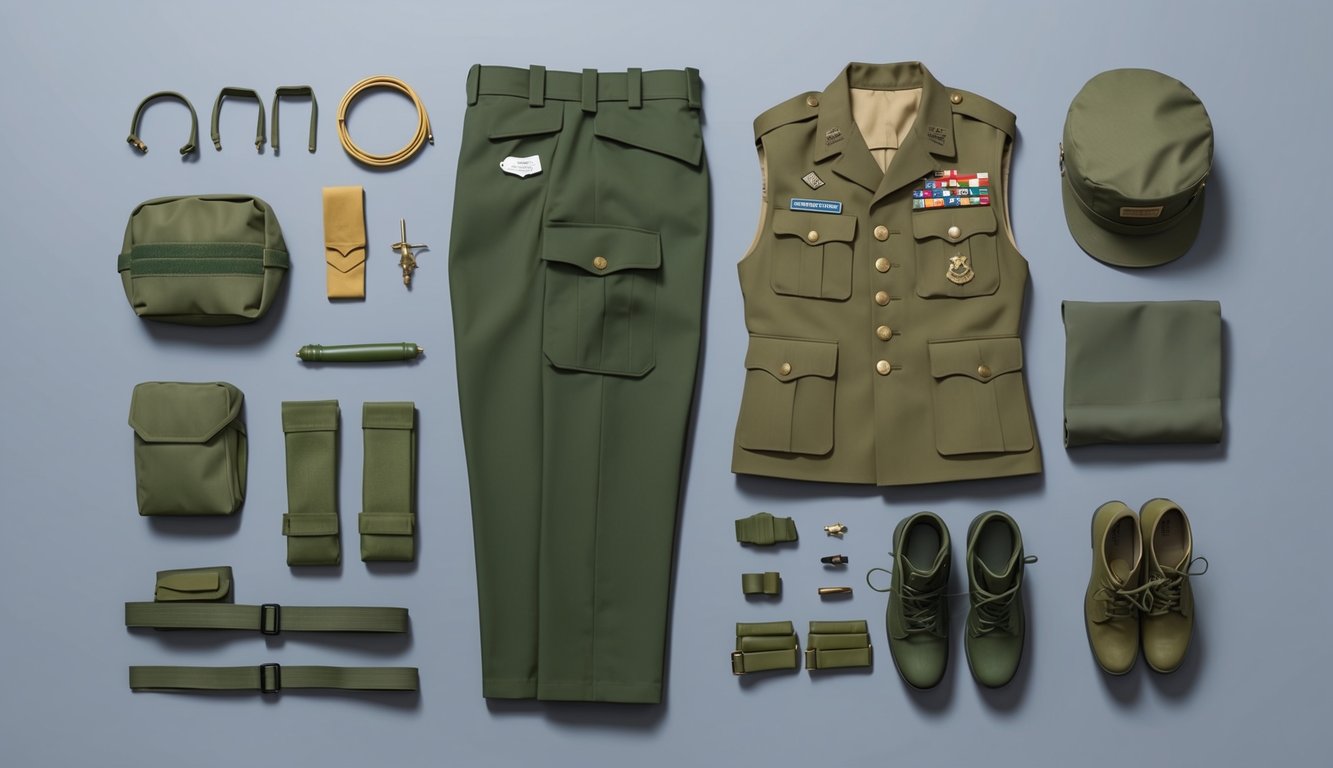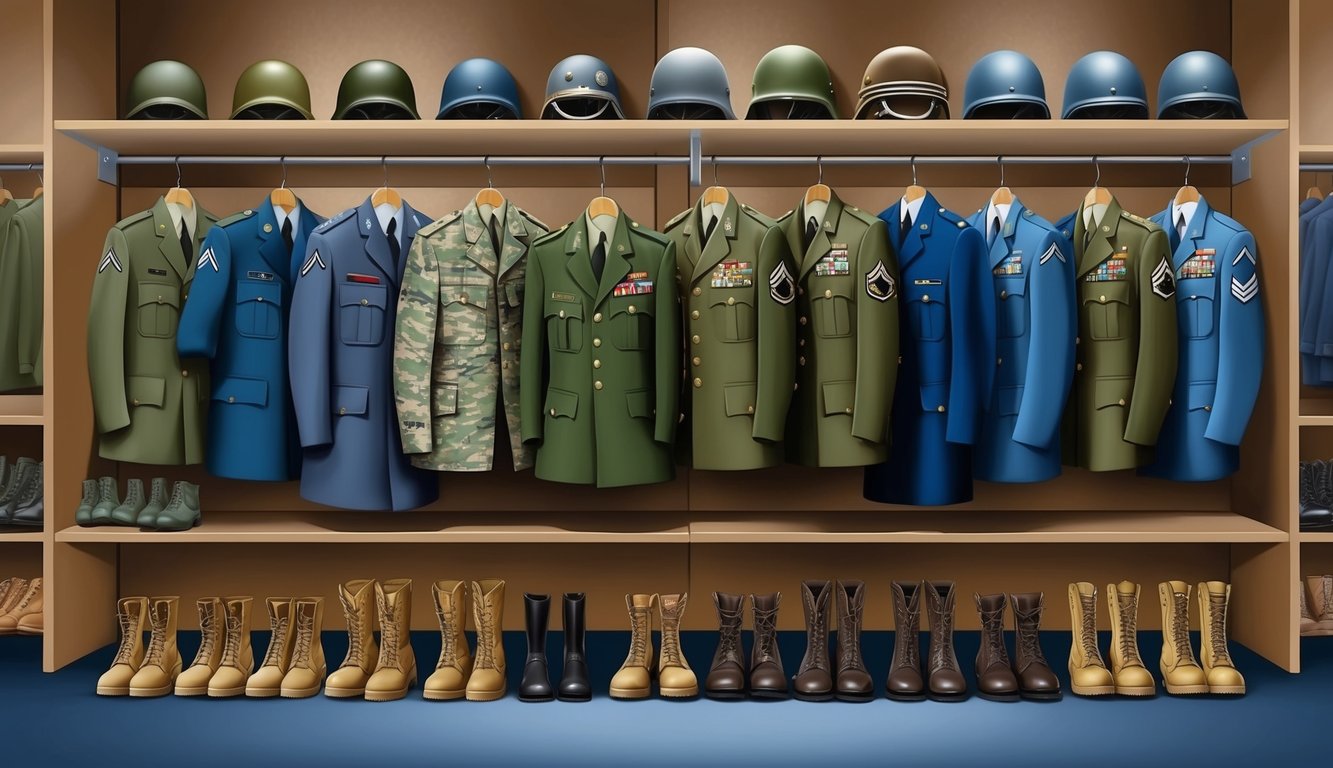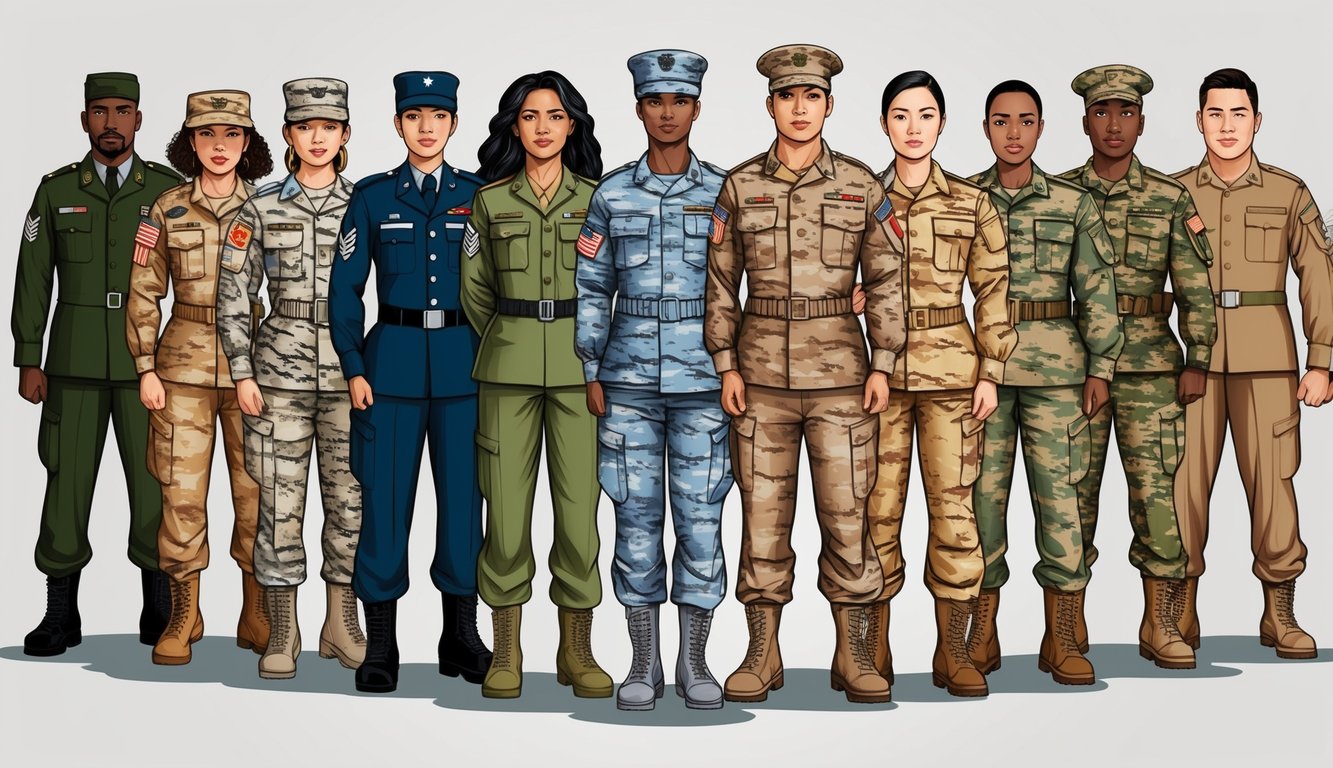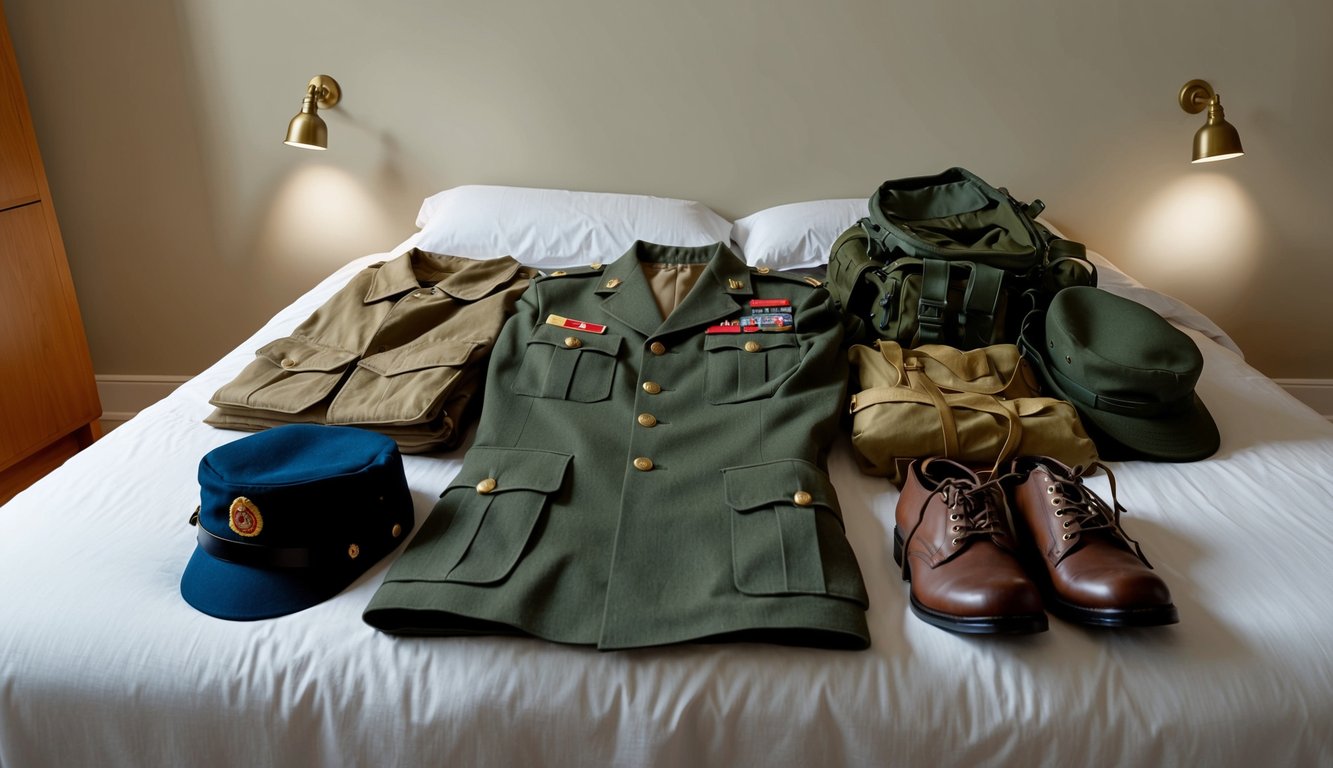Army Regulation 670-1, commonly known as AR 670-1, establishes uniform and appearance standards for the U.S. Army.
This extensive guideline encompasses everything from the correct way to wear uniforms to grooming requirements, ensuring a polished and unified appearance throughout the Army.
The Army’s dedication to upholding a disciplined and professional image while adapting to the changing needs of its soldiers is evident in AR 670-1. This regulation is regularly updated to incorporate modifications in uniform design, support new grooming practices, and foster inclusivity within the ranks.
Whether you are a new recruit or a long-serving veteran, grasping the contents of AR 670-1 is vital for your military career.
It not only dictates your uniform’s presentation but also reflects the Army’s core values and traditions.
Key Takeaways
- AR 670-1 details uniform wear, personal appearance standards, and grooming mandates for U.S. Army personnel
- The regulation is updated consistently to align with changes in uniform design and promote inclusivity
- Familiarity with AR 670-1 is essential to uphold professionalism and adhere to Army standards
Army Uniform Overview

The Army uniform is a crucial aspect of military service, symbolizing discipline and professionalism.
It visually embodies the values and traditions of the Army.
The Importance of the Army Green Service Uniform
The Army Green Service Uniform is the newest addition to the Army’s dress uniforms.
It recalls the classic “pinks and greens” from World War II, featuring a dark green jacket, a light tan shirt, a brown tie, and brown trousers or skirts.
This uniform is worn during formal events and official duties, designed to project a professional image while honoring the Army’s legacy.
Its tailored fit enhances appearance and builds confidence.
Wearing the Army Green Service Uniform properly signifies your dedication to Army standards and traditions.
Understanding the Army Combat Uniform (ACU)
The Army Combat Uniform (ACU) is your main duty uniform, crafted for comfort and functionality in various settings.
The ACU utilizes a digital camouflage pattern that aids in concealment across different terrains.
This uniform is worn for daily tasks, training, and combat scenarios.
It consists of a coat, trousers, t-shirt, and boots, with multiple pockets for essential gear and equipment storage.
Proper fit is essential for the ACU, allowing freedom of movement without excess looseness.
Regular maintenance, such as appropriate washing and ironing, ensures your ACU remains sharp and professional.
Wear and Appearance Standards
Army Regulation 670-1 provides clear directives on how soldiers should present themselves in uniform.
These expectations promote a professional, unified appearance, reflecting the discipline and pride of the U.S. Army.
Grooming Standards for Male and Female Soldiers
Your appearance as a soldier is paramount.
Keep your hair tidy and conservative.
For men, hair should not touch the ears or collar.
Women may style longer hair, but it must be secured.
Facial hair guidelines are strict, allowing only a neatly trimmed mustache, which must not extend beyond the corners of the mouth.
Beards are generally prohibited unless medical or religious considerations apply.
Nail polish and makeup must be subtle.
Clear nail polish is acceptable for all, and women may wear modest shades.
Makeup should enhance natural features without being overly striking.
Tattoos are permitted, but not on the face, neck, or hands.
They must also avoid extremist, indecent, sexist, or racist themes.
Hairstyle Protocols and Regulations
Your hairstyle must remain neat and be suitable for headgear.
Men’s hair should be tapered and not touch the ears or collar.
Sideburns should not extend below the bottom of the ear opening.
Women have a broader range of options but must keep their hair secured.
Braids, cornrows, and twists are acceptable if they are neat and conservative.
Buns cannot exceed 3.5 inches from the scalp.
Unnatural hair colors are not allowed.
Stick to shades that occur naturally in human hair.
Wigs or hairpieces must conform to the same standards as natural hair, appearing natural and professional.
Insignia Placement and Importance
Proper insignia placement is crucial as it identifies your rank, unit, and accomplishments.
On your dress uniform, rank insignia should be worn on both collars.
Unit patches are placed on the left shoulder.
Skill badges go above the left breast pocket, while combat patches are placed on the right shoulder if authorized.
Ribbons and medals indicative of your achievements should be worn in the correct order of precedence above your left breast pocket.
Name tapes must be positioned above the right breast pocket, and the U.S. Army tape should be above the left pocket.
Accessories and Their Proper Use
Accessories can complement your uniform but must be appropriately worn.
Headgear is a vital part of your uniform, to be worn outdoors and removed indoors unless under arms.
Sunglasses are permitted outdoors, provided they are conservative in style, avoiding mirrored lenses or trendy shapes.
Watches and rings should be simple and tasteful, with a limit of two rings and one watch.
Women can wear small, plain earrings in gold, silver, white pearl, or diamond.
Men are not permitted to wear earrings while in uniform.
Backpacks and bags should be black, brown, or match the camouflage patterns when in uniform.
Grooming Policies
Army grooming protocols aim to maintain a professional and uniform appearance while allowing for some personal expression.
These protocols encompass regulations for hair, facial hair, and nail standards for all soldiers.
Hair Standards and Acceptable Styles
You’re permitted to wear your hair in various styles, provided they are tidy and professional.
For female soldiers, ponytails and braids are permissible in most uniforms, with the length not interfering with headgear or extending past the uniform collar’s bottom.
Male soldiers should ensure their hair does not touch the ears or collar.
While fades or undercuts are acceptable, extreme styles are not permitted.
Both male and female soldiers can have highlights, but they should be in natural-looking shades.
Locs, twists, and cornrows are allowed if they remain neat and conservative.
Remember, your hairstyle must not hinder the use of military equipment or pose a safety risk.
Facial Hair Guidelines for Army Personnel
Generally, Army personnel are expected to be clean-shaven, with exceptions made for those with medical conditions who may receive a shaving profile.
Mustaches are permissible but should be kept neatly trimmed and must not extend beyond the corners of the mouth or cover the upper lip.
Beards are largely not allowed, although religious exemptions may be granted.
If approved, beards must be neatly trimmed and no longer than 2 inches in length.
Sideburns are permitted but cannot extend below the bottom of the ear opening.
Nail Regulations and Allowed Colors
Nails should always be clean and well-groomed.
Male soldiers must keep their nails short and they should not extend beyond the fingertips.
Female soldiers may have slightly longer nails, but they should not exceed 1/4 inch from the fingertip.
In uniform, only clear nail polish or neutral, subdued shades are allowed.
Bright colors, designs, or decorations are not permitted, and fake nails or extensions are banned for all soldiers in uniform.
These regulations apply whenever you are in uniform or on duty, aiming to maintain a professional appearance that represents the Army well.
Standards and Regulations
Army Regulation 670-1 outlines explicit expectations for uniform wear and appearance, encompassing everything from proper fit to conduct, including provisions for religious accommodations and medical exceptions.
Tailoring Uniforms for Fit and Functionality
A uniform reflects your professionalism; therefore, it should fit correctly and be functional.
Tailoring is permitted within regulatory boundaries to achieve a polished, professional look.
Sleeves should end at the wrist bone with arms at your sides, while trousers should break slightly on the shoe.
Avoid excessively tight or loose uniforms, as these can hinder movement and appear unprofessional.
If unsure about fit, consult your unit’s clothing and equipment specialists.
Remember, a well-fitted uniform not only looks sharp but also enhances your ability to perform your duties effectively.
Personal Conduct and Federal Uniform Code
When in uniform, you represent the Army, and your conduct should align with Army values.
Avoid inappropriate language and behavior, maintaining professionalism in public settings.
The Uniform Code of Military Justice oversees your actions, and violations may result in disciplinary measures.
Stay aware of your environment and how your behavior reflects on the service.
When in civilian attire on duty, select clothing that upholds a professional image, avoiding offensive slogans or imagery.
Religious Accommodations and Uniform Waivers
The Army values religious diversity while upholding uniformity.
Requests for religious accommodations can be made for practices requiring specific items like turbans, hijabs, or beards.
Requests should be submitted through your chain of command, with commanders reviewing each case on an individual basis.
Approvals will consider operational requirements and safety factors.
Medical waivers may also be granted for specific conditions, allowing for exceptions to grooming or uniform standards.
Ensure you provide appropriate documentation from medical professionals to support your request.
Adaptations for Environment

Army uniforms and equipment are adapted to suit various operational settings, ensuring soldiers remain effective and comfortable in diverse environments.
Uniform Wear in Garrison and Field Environments
In garrison, you will wear your dress or service uniform, which presents a polished appearance for office work and official functions.
Field conditions necessitate the use of combat uniforms such as the Army Combat Uniform (ACU), designed with a camouflage pattern for blending into various terrains.
Your conduct will also adjust; life in garrison involves more formal interactions and proper military courtesies, while fieldwork emphasizes tactical awareness and mission-focused behavior.
Maintain a clean and pressed uniform during garrison.
In the field, functionality is prioritized over appearance, but maintaining standards is still important.
Adjusting Army Uniforms for Extreme Conditions
Hot climates demand lighter, breathable fabrics; you may roll up sleeves or wear moisture-wicking undershirts.
Cold weather requires layering clothing: begin with a base layer, add insulation, and finish with a weather-resistant shell.
Desert environments should incorporate tan or sand-colored uniforms, while wooded areas utilize green and brown patterns.
Arctic deployments may necessitate white overgarments for camouflage purposes.
Always follow local command policies, as certain uniform adaptations may be allowed or restricted depending on the mission requirements and regional climate.
Equipment and Boots Standards
Your equipment should also adapt to environmental conditions.
In hot climates, ensure you carry ample water.
Cold weather operations will require additional cold-weather gear like gloves and thermal layering.
Army boots come in various styles to cater to different terrains.
Hot-weather boots are designed for ventilation, while cold-weather boots offer insulation, and jungle boots provide quick-drying properties for wet environments.
Proper maintenance of your equipment is crucial; clean and dry your gear after use, especially in tough conditions, to preserve its functionality and longevity.
Army Inclusivity Initiatives

The U.S. Army is making significant advancements in fostering diversity and inclusion through updated regulations.
These reforms encourage the acceptance of cultural differences while maintaining professional standards.
Promoting Diversity and Embracing Inclusion
The Army acknowledges the necessity of diversity to strengthen its personnel.
Recent updates to AR 670-1 reflect this commitment, allowing for an expanded range of hairstyle and grooming options.
These modifications recognize various cultural backgrounds and expressions, permitting soldiers to wear styles such as braids, twists, and locks in uniform, which supports maintaining cultural identity while serving.
Additionally, the Army now allows medium-length ponytails for women in all uniforms, addressing health concerns linked to tight hairstyles, such as hair loss and headaches.
Hair Regulations and Cultural Perspectives
Hair regulations have become a central focus in efforts toward inclusivity, with soldiers enjoying increased flexibility in styling their hair.
Women can now wear ponytails during physical training, applicable to those with medium to long hair lengths, providing practicality without compromising neat appearance.
Moreover, the Army has relaxed restrictions on natural hair colors; now highlights that mesh with natural hair hues are acceptable, promoting personal expression while upholding a professional look.
Restrictions on texture and length have also been eased, allowing diverse styling choices as long as safety protocols regarding headgear and military equipment are observed.
Body Art and Self-expression
The Army has revised its policy on tattoos and body art, offering soldiers greater freedom for self-expression.
Tattoos are now permitted on the hands and back of the neck, though facial tattoos remain prohibited.
These changes reflect shifting societal norms while ensuring a professional military appearance is upheld.
Nail polish options for women have expanded, allowing for a broader range of shades, granting more personal style choices.
Earrings are now allowed with the Army Combat Uniform (ACU) for female soldiers, a small but significant adjustment impacting daily comfort and self-expression.
Resources and Guides
Navigating Army regulations can be challenging; however, numerous resources are available to simplify understanding and compliance with AR 670-1.
These tools assist you in maintaining a sharp appearance in uniform.
AR670-1 Army Compliant Guide
An AR670-1 Army Compliant Guide serves as your essential reference for uniform standards.
These guides distill complex regulations into comprehensible formats, providing detailed explanations for each uniform component, from headgear to footwear.
Many guides offer clear images and diagrams to illustrate correct insignia and badge placement, often highlighting common errors to avoid and helping maintain a professional demeanor.
Seek guides that are consistently updated to reflect the latest modifications to AR 670-1; some may even feature mobile applications for quick access when needed.
Understanding Army Regulations Through Review Articles
Review articles can provide critical insights regarding AR 670-1, frequently elaborating on the rationale behind specific regulations and their relation to Army values.
You may find articles discussing recent updates, offering context for changes, or covering the historical evolution of Army uniforms and grooming practices.
Focus on articles authored by experienced NCOs or officers.
Their insights can deepen your understanding of the significance of adhering to these guidelines.
Utilizing Top 10 Lists for Quick Reference
Top 10 lists serve as a fast-track method to revisit the essential points of AR 670-1.
These lists often center on the most common infractions concerning uniforms or frequently posed questions.
Examples of topics you might find include:
- Top 10 grooming mistakes to avoid
- Most crucial uniform regulations to remember
- Quick tips for successfully passing uniform inspections
These concise lists are perfect for last-minute refreshers before formations or inspections and can easily be shared with comrades to help uphold unit standards.
Frequently Asked Questions
AR 670-1 is periodically updated to respond to evolving needs and standards within the Army.
This section addresses recent changes, how to access the latest version, and critical regulations that soldiers often inquire about.
What modifications were recently made to AR 670-1?
The latest updates allow female soldiers to wear earrings with the Army Combat Uniform, except in combat or field scenarios.
Hair regulations now encompass natural styling, permitting up to 1.5 inches of root growth for varying colors.
These adjustments aim to find a balance between professionalism and personal expression, emphasizing natural hair colors, regardless of ethnicity.
How can I obtain the latest AR 670-1 PDF?
You can download the most recent AR 670-1 PDF from the Army Publishing Directorate website by searching for “AR 670-1” in the publications database.
Alternatively, check your unit’s SharePoint or intranet resources for availability.
It is crucial to ensure you are utilizing the most current version for accurate guidance.
Could you explain the belt regulations in AR 670-1?
Belt color must correspond to the uniform.
For ACUs, a tan rigger belt is required, while ASUs call for a black web belt featuring a brass tip and buckle.
The belt should be threaded through all loops, and the excess length must not exceed 4 inches when tucked into the first belt loop on your left side.
What does it mean for a uniform to be AR 670-1 compliant?
An AR 670-1 compliant uniform conforms to all standards stipulated in the regulation, including appropriate fabric, color, fit, and authorized accessories.
Compliance also includes proper wear, which encompasses accurate insignia, patch, and name tape placement, alongside grooming standards that complement the uniform.
Where can I find the most current AR 670-1 update?
The latest version of AR 670-1 is available on the Army Publishing Directorate website.
Check the publication date to ensure you are reviewing the most recent changes.
Your unit’s S1 or personnel office may also provide insights regarding the latest updates, as they often receive information before it is widely distributed.
What are the grooming standards according to the latest AR 670-1?
The updated AR 670-1 indicates that hair must be neat, clean, and well-groomed.
For men, hair should not touch the ears or collar, and sideburns cannot extend below the bottom of the ear opening.
For women, when styled in a bun, hair must not exceed 3.5 inches from the scalp.
Nail polish may be worn in subtle colors for women, but men are prohibited from using it.
Generally, facial hair is disallowed, except for sanctioned medical or religious allowances.

